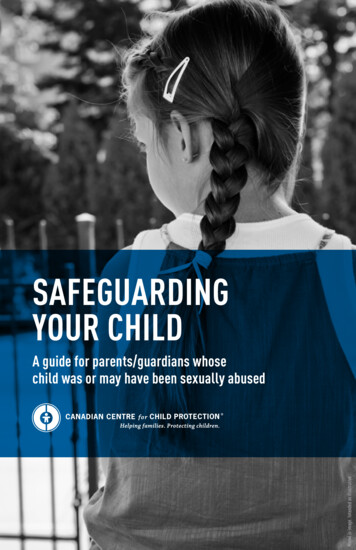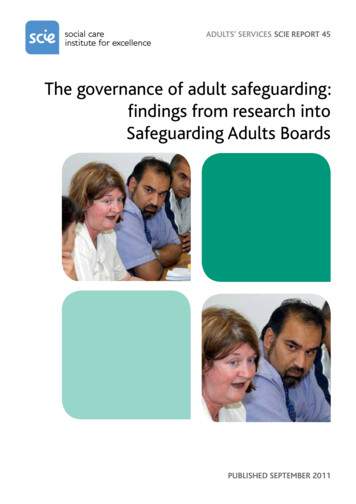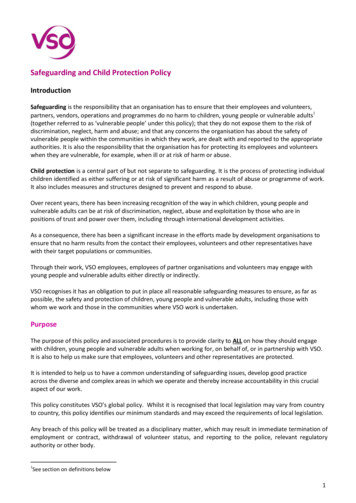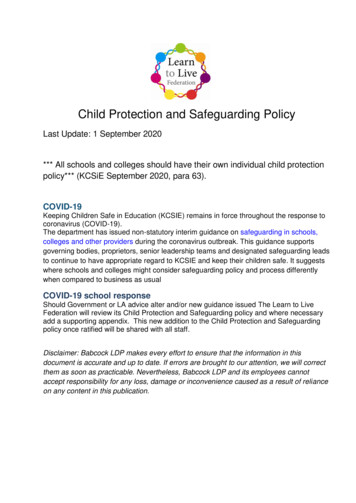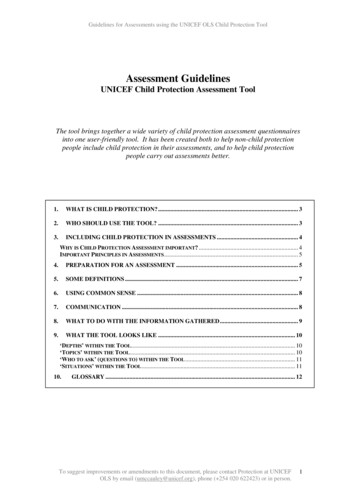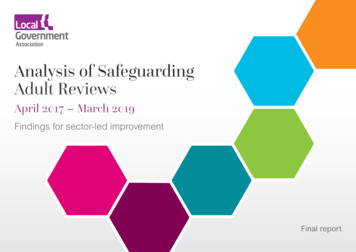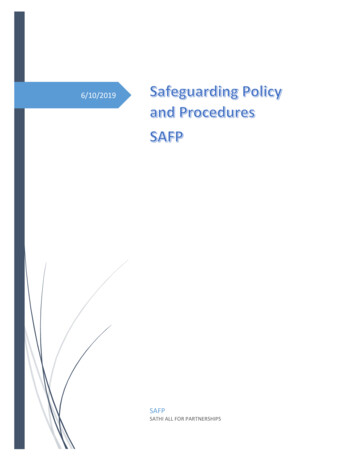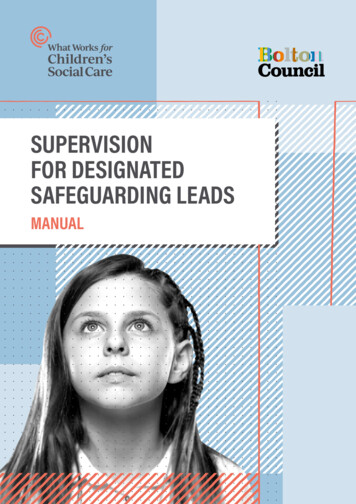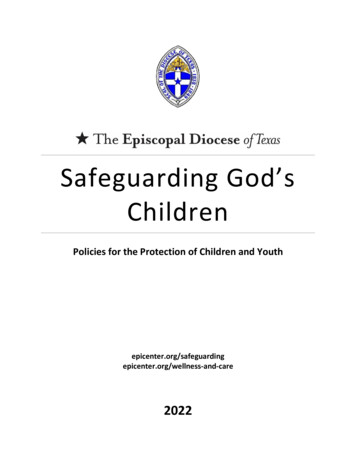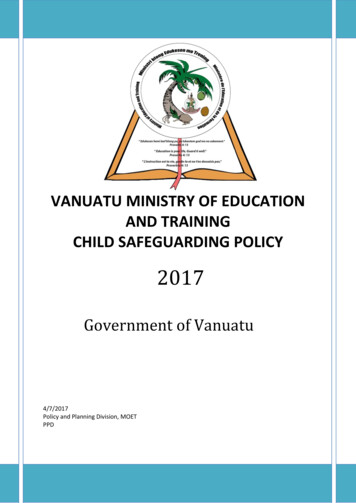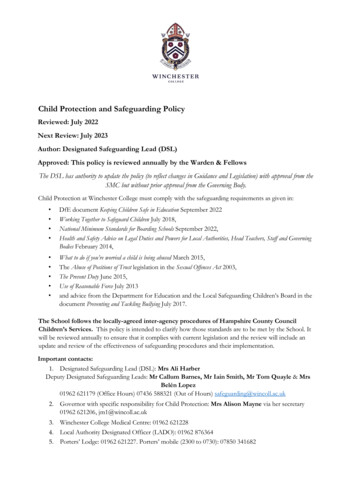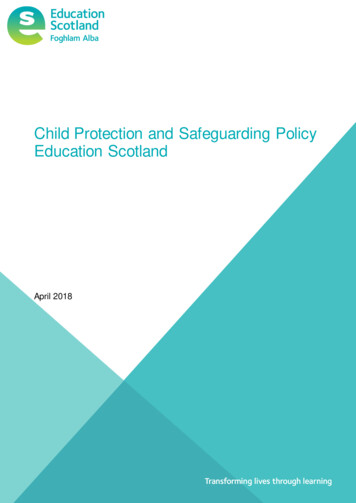
Transcription
Child Protection and Safeguarding PolicyEducation ScotlandApril 2018
Name of PolicyChild protection and Safeguarding Policy, Education Scotland –Inclusion and EqualityDescription of PolicyPolicy NumberPolicy Status New Revision of Existing Policy Withdrawal of Policy Scottish Government AdoptedAuthorMonica McGeever, Lead Officer SafeguardingOwner and business areaInclusion and EqualityApprover (Assistant director orabove)Mary HoeyApproval DateJuly 2017Effective DateSeptember 2017Date of Next Policy Review*July 2018Frequency of reviewAnnualDate of review* Unless otherwise indicated, this policy will still apply beyond the review date.Description of AmendmentVersion 0.1Related Legislation, Strategies,Policies, Procedures, Guidelines andLocal ProtocolsApril 2018First draftDetailed on page 4.
ForewordEducation Scotland actively promotes the welfare and wellbeing of its employees andof all children, young people and adults whom Education Scotland staff come incontact with during inspection, review activity or other forms of engagement. Inparticular, as an organisation we are committed to ensuring: children’s and young people’s rights to care and protection from harm in anyform are firmly upheld; adult learners’ personal interests, dignity and care are safeguarded; we fulfil our legislative duties related to safeguarding, including child protection; the interests of all Education Scotland staff including secondees, AssistantInspectors, Associate Assessors and Lay Members are safeguarded as theygo about their work and engage with learners of all ages in our communities;and all staff within Education Scotland, including Corporate Services personnel,are suitably trained in safeguarding matters.April 2018
SAFEGUARDING POLICYThis policy provides the framework within which Education Scotland staff, individually andcollectively, can understand their responsibilities in relation to safeguarding/childprotection and promoting the welfare of children1 and protected adults 2.What do we mean by Child Protection and Safeguarding?Child Protection - Protecting a child from child abuse or neglect. Abuse or neglect neednot have taken place; it is sufficient for a risk assessment to have identified a likelihood orrisk of significant harm from abuse or neglect.Safeguarding - This is a much wider concept than child protection and refers topromoting the welfare of children, young people and protected adults. It encompassesprotecting from maltreatment, preventing impairment of their health or development,ensuring that they are growing up in circumstances consistent with the provision of safeand effective care; and taking action to enable all children, young people and protectedadults to have the best outcome. Child protection is part of this definition and refers toactivities undertaken to prevent children suffering, or likely to suffer, significant harm.We have a distinctive approach to safeguarding in Scotland linked to Getting It Right forEvery Child (GIRFEC) which promotes action to improve the wellbeing of every child andyoung person. Safeguarding is a golden thread that runs through the curriculum. Theaim is to support the development of learner’s knowledge, skills and resilience to keepthemselves safe and protect themselves and to develop an understanding of the world sothat they can respond to a range of issues and potential risky situations arisingthroughout their lives. As such, it permeates many features of the education experienceincluding leadership, values, vision, the curriculum, learning and teaching, positiverelationships, building learner resilience, etc.In all Education Scotland’s work, the needs, interests and wellbeing of childrenand young people and protected adults must be put above the needs and interestsof all others. Hence, this Policy and the guidance contained within it must havepriority over all other policies and advice.Working in partnership with stakeholders, Education Scotland seeks to ensure that:Differing legal definitions of the age of a ‘child’ can be confusing. The priority is to ensure that avulnerable young person who is or may be at risk of harm is offered support and protection.References within this policy to children are intended to r efer to children and young people up tothe age of 18 years.12A protected adult is defined as an individual aged 16 or over who is provided with (and thusreceives) a type of care, support or welfare service. Protected adult is therefore a service base ddefinition and avoids labelling adults on the basis of them having a specific condition or disability.1
providers of education in Scotland enable children, young people and adults to besafe, nurtured, achieving, healthy, active, included, respected and responsible;andchildren, young people and adults in Scotland become successful learners,confident individuals, responsible citizens and effective contributors in centres oflearning, the workplace and community.We do this by: always putting the needs of, and desired outcomes for, children and adultlearners in centres of learning, the workplace and the community at theforefront; accounting rigorously and clearly to them, their families, Ministers and thepeople of Scotland on the quality of education and other services; and promoting high quality equitable outcomes for all learners by eliminatinginequity that exists amongst learners from different backgrounds and particularvulnerable groups.In carrying this out, Education Scotland staff recognise their professional and legalobligations to protect children, young people and adult learners, particularly those atrisk. Education Scotland will promote safe practice to protect children, young peopleand adults from harm, abuse and exploitation.This policy aims to ensure that: Education Scotland operates a robust and safe selection and appointmentprocess which requires all employees who have opportunities to engageregularly with children in the course of their normal duties be members of theProtecting Vulnerable Groups (PVG) Scheme and to participate in relevantprofessional learning; during all of our inspection/review activity and other forms of engagement, wecreate a safe environment for children, young people and adults at risk, and theadults who work with them; Education Scotland staff are equipped with the information, knowledge, supportand guidance to keep children, young people and adults at risk, safe andprotected; and we take account of local inter-agency child protection guidelines and eachlocal authority’s legal obligation to safeguard and protect any group at risk,including children and protected adults.Principles of this Policy The welfare of all children, young people and protected adults is alwaysthe primary concern. Protecting children, young people and protected adults is everyone’sresponsibility. Every child, young person and protected adult should be treated as anindividual and has a right to a positive sense of identity. All children, young people and protected adults have the right to be protected2
from all forms of abuse, neglect and exploitation. All children, young people and protected adults have the right to express theirviews on matters affecting them.To promote these principles we will: Treat everyone with respect and encourage children, young people andprotected adults to respect others;Promote the rights, including privacy and dignity, of children, young peopleand protected adults as defined by the United Nations Convention on theRights of the Child (UNCRC);Respect confidentiality and only share information and concerns about children,young people and protected adults with those who need to know;Take action to stop any inappropriate verbal or physical behaviour and emotionalabuse, including bullying;Treat all concerns and allegations seriously and respond appropriately, operatingwithin our agreed policy, procedures and guidance; andRefer, not investigate.Everyone has a responsibility to protect young people and protected adults.Everyonea responsibilityto protectchildren,adult,youngan has a right to feelEveryhaschild,young personand protectedat peopleall times,Everysafechild,youngpersonandanyhas,at all times,a rightwhichto feelmaysaferesultand in harm.andprotectedfromsituationor practiceprotected from any situation or practice which may result in physical oremotionalAboveharm.all, the welfare of children, young people and protected adults is theparamount consideration and we must all work together to ensure they areprotected.3
Policy and legislative contextThe Children (Scotland) Act 1995 places a duty on schools and local authorities tosafeguard and promote the welfare of 0191408/14360Safeguarding sits within the context of the wider Getting it right forevery child (GIRFEC) approach, le/gettingitright, the Early Years 2009/01/13095148/0 and the UN Convention onthe Rights of the Child, /UNCRC PRESS200910web.pdf.The Scottish Government wants Scotland to be the best place in the world forchildren and young people to grow up so that they become successful learners,confident individuals, effective contributors and responsible citizens. All children andyoung people have the right to be cared for and protected from harm and abuse and togrow up in a safe environment in which their rights are respected and their needs met.Children and young people should get the help they need, when they need it and theirsafety is always paramount.GIRFEC promotes action to improve the wellbeing of all children and young people ineight areas. These wellbeing indicators state that children and young people must be:healthy, achieving, nurtured, active, respected, responsible, included and, above all inthis context, safe. The primary indicator for child protection is to keep a child safe and, inso doing, attention is given to other areas of wellbeing as appropriate.The Children and Young People (Scotland) Act 2014 sets out duties on a rangeof public bodies to report on how they are taking forward children’s rights as set out in theUNCRC. Moreover, ratified by the UK Government in 2009, the UN Convention on theRights of Persons with Disabilities stipulates that in order for disabled children to be ableto realise the rights mentioned above, they need to be provided with disability and ageappropriate assistance.In addition to the Convention, the Children’s Charter was drawn up followingconsultation with children and young people as part of the Scottish Government’s childprotection reform programme. The Charter sets out a list of demands children shouldfeel entitled to make including the need to be safe. The Framework for Standards 2/34603) is the detailed means fortranslating the commitments made in the Children’s Charter into practice. In working withchildren and their families, all practitioners should strive to adhere to the following bestpractice standards.The National Guidance for Child Protection in Scotland 2014http://www.gov.scot/Resource/0045/00450733.pdf provides a national framework withinwhich agencies and practitioners at local level – individually and jointly – can understandand agree processes for working together to support, promote and safeguard and thewellbeing of all children. It sets out expectations for strategic planning of services toprotect children and young people and highlights key responsibilities for services andorganisations, both individual and shared.All agencies, professional and public bodies and services that deliver adult4
and/or child services and work with children and their families have a responsibility torecognise and actively consider potential risks to a child, irrespective of whether thechild is the main focus of their involvement. They are expected to identify andconsider the child’s needs, share information and concerns with other agencies andwork collaboratively with other services (as well as the child and their family) toimprove outcomes for the child.Across Scotland, local arrangements are now well established to meet localgeographic and demographic demands and service user needs. Chief Officers areresponsible for determining the most appropriate child protection arrangements fortheir respective area(s). Chief Officers‟ Groups have strategic responsibility for theirChild Protection Committees (CPCs) . Further information on the role and functions ofCPCs can be found in the National Guidance for Child Protection in Scotland 2014.Child protection policy must pay due attention to equality and diversity issues.Access to, and delivery of, child protection services should be fair, consistent,reliable and focused on individual outcomes and enablement. Service users shouldbe listened to, respected and responded to. There should be no discrimination on thegrounds of race, disability, gender, age, sexual orientation, religion or belief, genderreassignment or on the basis of pregnancy and maternity. The Equality Act 2010http://www.gov.scot/Topics/People/Equality restates, streamlines and harmonisesequality legislation.The ‘Common Core of Skills, Knowledge & Understanding and Values for the “Children’sWorkforce” In Scotland’ (2012) - cribes the essential characteristics that everyone should have if they work withchildren, young people and their families. These essential characteristics embody thevalues of the GIRFEC approach are cross-referenced to the guiding principles of theUNCRC: Non-discriminationBest interests of the childThe child’s right to life, survival and developmentRespecting the views of the child.Education Scotland has a support and monitoring duty within the context of safeguardingin relation to Prevent, Section 26 of the Counter-terrorism and Security Act, 2015,which places a duty on central bodies to have’ due regard to the need to prevent peoplebeing drawn into system/uploads/attachment data/file/445978/3799 Revised Prevent Duty Guidance Scotland V2.pdfThe Children and Young People (Scotland) Act 2014 puts Corporate Parenting on astatutory footing and introduces a new framework of duties and responsibilities for the 24public bodies listed in Schedule 4 as corporate parents. Education Scotland, as anExecutive Agency of the Scottish Government is subject to the corporate duties set out inPart 9 of the Act. These duties were commenced on 1 April 2015 and require allcorporate parents to collaborate with each other to promote the wellbeing of looked afterchildren and care leavers in their care and enable them to achieve the best outcomes.5
The statutory guidance for Corporate Parenting provides corporate parents withinformation and advice about how they should fulfil the duties set out in Part 9 (CorporateParenting) of the 2014 Act. Corporate parents compliance with the legislation will bemonitored through the review of corporate parenting reports (by Scottish Ministers),independent inspection mechanisms (such as those provided by the Care Inspectorate,Education Scotland, Healthcare Improvement Scotland and Her Majesty’s Inspector ofConstabulary in Scotland) and corporate parents’ existing governance arrangements(such as councillors, parliamentarians and non-executive board members).Independent SchoolsThe legislative framework for the registration and regulation of independent schools iscontained within sections 98 to 103B of the Education (Scotland) Act 1980 with specificrequirements related to safeguarding and promoting the welfare of a pupil attending theschool. The Scottish Council for Independent Schools (SCIS) provides the sectorsupport and professional learning on child protection including publication of guidance:Guidance on Wellbeing and Child protection 2015 ng/Post-school educationThe Adults with Incapacity (Scotland) Act 2000 and the Protection of Vulnerable Groups(Scotland) Act 2007 iterate the rights detailed in the United Nations Convention on theRights of the Child, 1991, and the Human Rights Act 1998 for vulnerable adults.The HMIE aspect report on Safeguarding arrangements and practice inScotland’s colleges, 2010, set out the legislative framework for ary of responsibilities of Education Scotland staffEducation Scotland does not have direct responsibility for the delivery of services, or forinvestigating matters related to safeguarding/child protection. Education Scotland iscommitted to promoting the welfare and wellbeing of its employees and all children,young people and adults who staff come in contact with during all our work. Safeguardingis the responsibility of everyone in Education Scotland regardless of their individual role.This policy, together with our Safeguarding code of practice and guidance andappropriate professional learning will support our staff in fulfilling their safeguardingresponsibilities and duties. We have both an internal safeguarding role in terms ofsupporting staff in dealing with safeguarding responsibilities and duties as well as anoutward facing role though capacity building, inspection and review and providingprofessional policy advice.We will support all our staff, including secondees, Associate Inspectors and LayMembers and ensure they: 6are appointed following appropriate and stringent safe recruitment procedures;are supported through appropriate professional learning to raise their awarenessof the need for safeguarding children, young people and protected adults, know
their responsibilities and are familiar with the procedures to follow when theyhave concerns; andtake actions to respond to allegations, suspicions or incidents of abuse andensure all safeguarding concerns are shared with the relevant head ofestablishment/service/education authority/governing body in order that they cantake appropriate action.We will build capacity by supporting professional learning communities and networks ofkey educational staff from local authorities and the independent school sector, who areresponsible for supporting educational establishments and services with safeguardingmatters. Our focus will be on supporting others to undertake their safeguardingresponsibilities.We will support and promote the development of the ‘Scottish Approach to Safeguarding’through a responsive, flexible and inclusive framework within Curriculum for Excellence(rather than taking an issue-by-issue approach). The aim is to support the developmentof children’s and young people’s knowledge, skills and resilience to keep themselvessafe and protect themselves and to develop an understanding of the world so that theycan respond to a range of issues and potential risky situations arising throughout theirlives.Through inspection and review, we will: ensure a strong focus on how well education providers carry out theirresponsibilities in a manner which safeguards children, young people andprotected adults; evaluate how well education providers have appropriate safeguardingprocedures in place and that these are both linked or built into locally agreedmulti-agency procedures; and provide assurance to the public and Ministers that education providers arefulfilling their responsibilities in ensuring the safety and wellbeing of children,young people and protected adults.We will provide professional advice on developing policy working with the ScottishGovernment, the Registrar for Independent Schools, other agencies and local andnational partners particularly in relation to child protection, Prevent, Child SexualExploitation, and by contributing to the Scottish Child Abuse Inquiry to develop strategiesthat are designed to prevent and/or reduce the risk of abuse from occurring.We will deliver on our statutory duties in relation to Corporate Parenting towards lookedafter children.We will, in partnership with Scottish Government monitor Glow reports of concern.How Education Scotland will discharge its responsibilities for safeguardingWe have put in place the following measures to ensure we deliver on our responsibilitiesand duties in relation to safeguarding.Responsible officersIn order to ensure that we discharge our responsibilities appropriately, we have:7
a designated Strategic Director, with responsibility for the strategic oversight of allaspects of safeguarding within Education Scotland and who is accountable to theChief Executive Officer (CEO);a designated Assistant Director with line management responsibilities, andmanagement reporting responsibilities for safeguarding;a Lead Officer with the operational and project management responsibilities forsafeguarding, including dealing with disclosures and referrals, the provision ofadvice and guidance to Education Scotland staff in dealing with disclosures andreferrals, and the oversight of advice and guidance for safeguarding;a designated Human Resources (HR) officer for the oversight of all recruitmentand Human Resources HR functions relevant to Education Scotland’ssafeguarding responsibilities as an employer, including those in respect ofappointing secondees, Assistant Inspectors, and Lay Members;designated administrative support safeguarding officers; anda cross-directorate safeguarding working group to provide guidance and oversightand support within the teams the members represent.Safeguarding Lead Officer roleWorking with the Assistant Director, the Safeguarding Lead Officer will:Leadership Provide leadership and advice across Education Scotland in relation to allaspects of safeguarding;Act as the first point of contact for advice on safeguarding disclosures andreferrals for members of staff and for external bodies;Provide the Strategic Director and Assistant Director with advice and regularupdates on safeguarding matters and their implications for on-going professionallearning of staff; andWork with the relevant Assistant Director to ensure the above responsibilities aremet in fullPolicies Ensure that Education Scotland’s policies, procedures and guidance onmanaging safeguarding and inspecting safeguarding are reviewed at leastannually and kept up to date in line with Scottish Government policies andrelevant legislation; andInform staff of Education Scotland’s policy and procedures and make themaware of their roles and responsibilities in recognising and acting upon indicatorsthat a child’s, young person’s or protected adult’s welfare or safety may be atrisk.Concerns 8Ensure that staff take positive actions to respond to allegations, suspicions orincidents of abuse;
Make all necessary causes of concern, record concerns using relevantsafeguarding reports, and monitor follow-up activity to ensure all appropriateaction is taken;Monitor the nature and the outcome of causes of concern to recognise patterns;andTake action to ensure the line manager, HR or the person’s employer is informedwhere a safeguarding allegation is made against a member of staff, secondee,an Associate Assessor or Lay Member.Professional learning Ensure that all staff are aware of the need for safeguarding children, youngpeople and protected adults and that staff are familiar with the procedures tofollow when they have concerns;Liaise with HR to co-ordinate professional learning for Education Scotland staffand work with other agencies to provide effective professional learning onsafeguarding;Provide guidance on inspecting safeguarding;Advise and support sector and other Lead Officers in drafting supplementaryguidance on inspecting safeguarding; andAdvise and support sector Lead Officers in responding to queries aboutinspection methodology with regard to safeguarding.Joint working Work with Scottish Government, other agencies and local and national partnersto respond national and local initiatives and to develop strategies that aredesigned to prevent or reduce the risk of abuse;Work with the Care Inspectorate to support the safety and wellbeing of peoplewho use or are eligible to use care services. The Memorandum ofUnderstanding between Education Scotland and The Care Inspectorate 20152018 sets out the commitment to work together to improve the quality ofeducation and care for children and young people; andWork with the Registrar for Independent Schools to provide independent scrutinyof education provision through various means including inspection ofindependent schools.Reporting 9Provide regular reporting on safeguarding practice to the Assistant Director andStrategic Director to allow updating of senior leadership team at least biannually;Maintain an on-going summary and end-of-year evaluation of relevant issues,including the implementation of Education Scotland’s safeguarding procedures,an analysis of enquiries, queries and referrals made to Education Scotland; andAdvise the Registrar for Independent Schools, Scottish Government Official andMinisters of any action required to safeguard children and vulnerable adultsincluding any advice that needs to be given to other statutory bodies, for examplethe Care Inspectorate.
If you have any comments or questions about this policy or would like furtherinformation, please contact Enquiries@educationscotland.gsi.gov.uk10
April 2018 Name of Policy Child protection and Safeguarding Policy, Education Scotland - Inclusion and Equality Description of Policy Policy Number Policy Status New Revision of Existing Policy Withdrawal of Policy Scottish Government Adopted Author Monica McGeever, Lead Officer Safeguarding Owner and business area Inclusion and Equality
